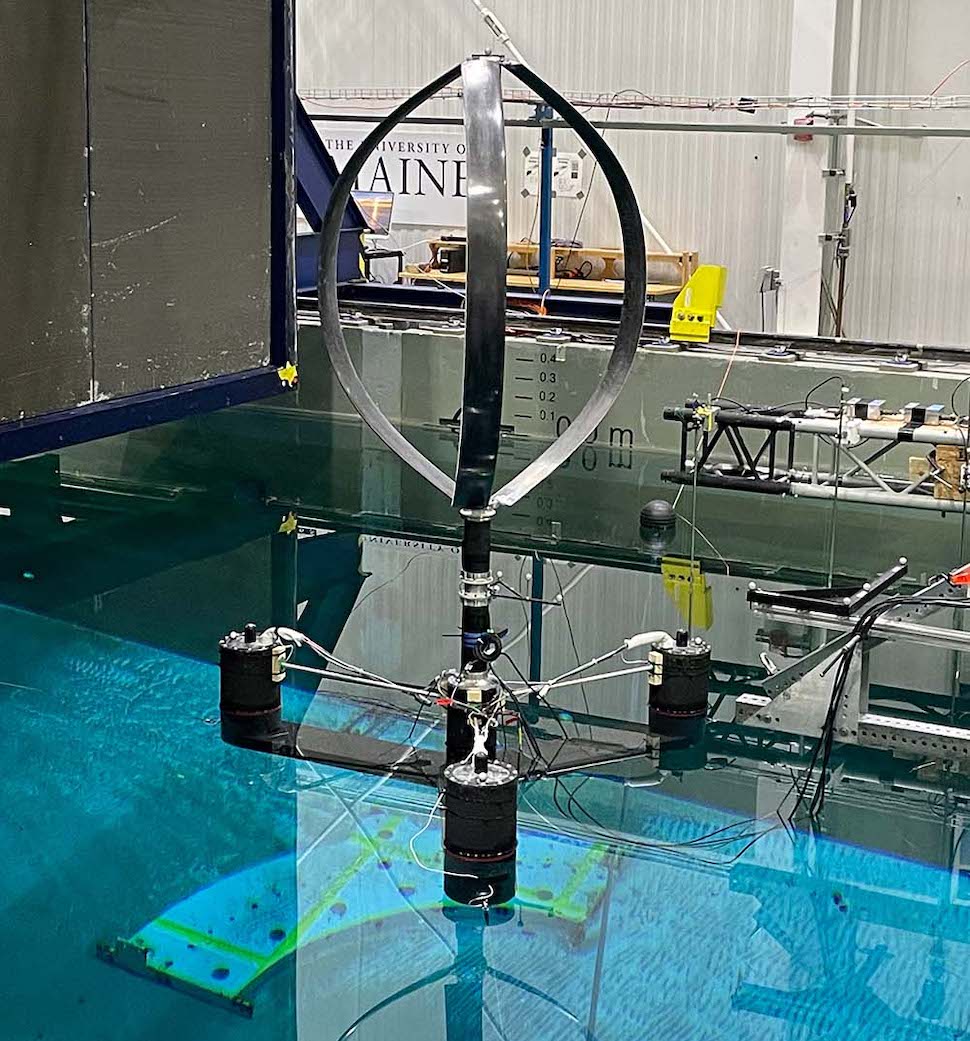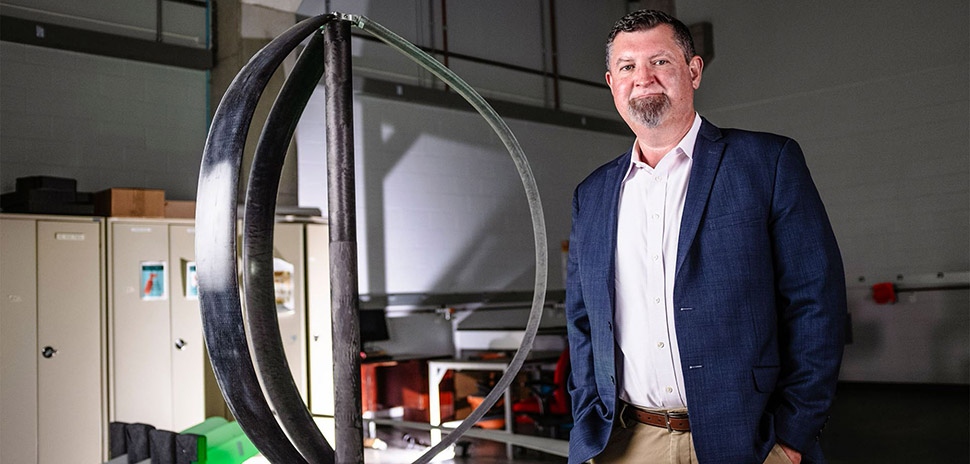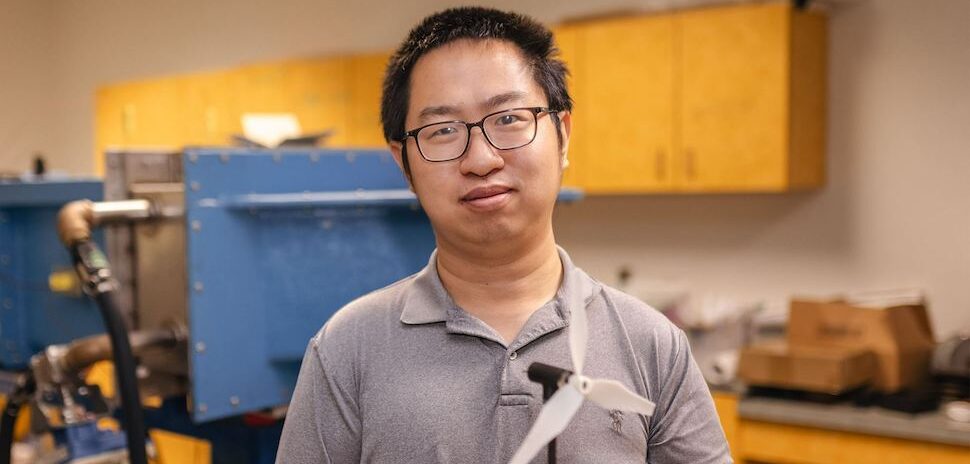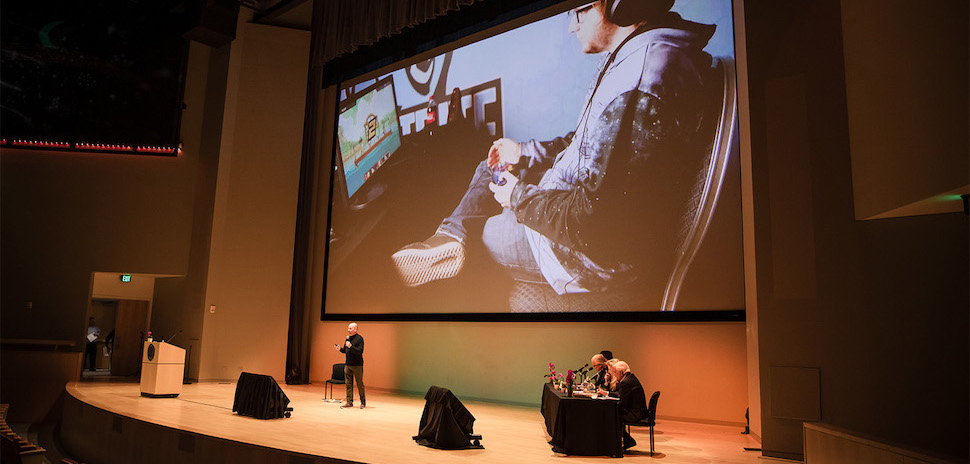Massive, long-bladed wind turbines are anchored to the shallow sea floor of countries around the world, especially in Northern Europe and China. The U.S. has been slower to adopt the technology due to costs, local opposition, and regulatory/supply chain hurdles. But a different solution could move wind farms further out into the sea, changing the game entirely. And a team of UT Dallas researchers is hot on the trail.
One big difference: Their proposed turbine looks more like an egg beater than a traditional windmill.
“Our turbine is designed to make offshore wind power safe, efficient and affordable,” says UTD Professor Dr. Todd Griffith, whose lab contains a 6-foot-tall, small-scale prototype of what could eventually become a 900-foot-tall upside egg beater floating far above the deep ocean floor. If successful, the technology could capture “untapped potential energy” from wind blowing across deep ocean water, the university said.
Griffith and his team of UTD engineers recently put the prototype through extensive testing to show that it works.
The next big test? Scaling it up as high as 500 feet tall to prove it works in a real-world situation. Ultimately, the offshore turbine could reached the stunning height of 900 feet—as tall as a 72-story skyscraper—generating electricity from winds over the deep ocean “miles from the coast and out of view from land,” UTD said.

UTD researchers tested their prototype at the University of Maine, which has a facility that can simulate wind and wave conditions.[Photo: UTD]
Texas already leads the U.S. in wind energy
It’s not surprising that this research is happening in North Texas. The Lone Star State leads the nation in wind energy, with 19,000 wind turbines spinning away as of September 2024, according to the U.S. Wind Turbine Database.
Griffith calls his team’s work “important” for enabling energy independence and reliability for Texas, which has made it a priority to increase the capacity of the electricity grid.
“In the U.S., we have a major opportunity to develop offshore wind energy systems that can enhance energy capacity to the power grid in coastal areas,” Griffith said in a statement. “To access wind energy in deep ocean water, however, we need a different solution. Our turbine is designed to make offshore wind power safe, efficient and affordable.”
Nearly $8 million in ATLANTIS program grants
The professor of mechanical engineering in the Erik Jonsson School of Engineering and Computer Science recently received a $4.42 million research grant from the U.S. Department of Energy to advance the project, extending a 2019 grant of $3.3 million grant awarded in 2019 for a total DOE investment of $7.72 million.
The Advanced Research Projects Agency-Energy (ARPA-E) award is part of the Aerodynamic Turbines, Lighter and Afloat, with Nautical Technologies and Integrated Servo-control (ATLANTIS) program, which aims to develop new and potentially disruptive innovations in floating offshore technology.
The research is not tied to any existing offshore wind energy farms, UTD noted.
More on the ‘vertical axis wind turbine design’
Griffith joined UTD in 2017, eight years after he began investigating vertical-axis wind turbine designs as a principal member of the technical staff and offshore technical lead at Sandia National Laboratories’ Wind Energy Technologies Department.
His design features a vertical axis of rotation that’s very different from traditional three-blade horizontal-axis turbines. The turbine sits on a platform partly above and partly below the ocean’s surface and is attached to the sea floor with cables. Unlike traditional turbines, the generator and controls are at the water level in the platform. UTD said this provides greater stability and facilitating maintenance, with a cable along the sea floor delivering electricity to the land.
Weighing just 10 pounds, the prototype is made with composite materials. When wind pushes against the prototype’s blades, they rotate to create a twisting force, or torque, that generates electricity.
Along with focusing on lightness, the team is even more focused on safety.
“We’re developing a new safety system to protect the turbine in high-wind conditions, including bringing the turbine to a stop if necessary,” Griffith said.
One of several UTD Wind projects

UTD’s wind tunnel, the Boundary Layer and Subsonic Wind Tunnel. [Image: UTD]
Griffith’s deep-ocean wind turbine project is one of several research initiatives based in UTD’s Wind Energy Center, also known as UTD Wind. Griffith serves as deputy director for UTD Wind, which is dedicated to the advancement of wind energy science and engineering.
In November, Dallas Innovates wrote about a UTD assistant professor, Dr. Yaqing Jin, who was inspired by seal whiskers to help develop a sensor to monitor turbulence in the deep ocean, which can damage wind turbines under operation.
In addition research like Griffith’s and Jin’s, UTD Wind also provides opportunities to train future wind energy experts, including a growing number of students interested in the energy industry.
Griffith’s project involves collaborations with other universities as well, including the University of Maine, where the UTD team tested their prototyp at a research facility that can simulate wind and wave conditions. The researchers are also testing their design in UT Dallas’ own wind tunnel, called the Boundary Layer and Subsonic Wind Tunnel.
Dr. Mario Rotea, director of UTD Wind and professor of mechanical engineering, said the DOE grants for Griffith’s project will continue to support student researchers, some of whom have gone on to work in the wind energy industry.
“We’re pleased to play a role in advancing wind power generation through our research at UTD Wind,” Rotea, an expert in control systems and a collaborator on the offshore turbine project, said in a statement.
Don’t miss what’s next. Subscribe to Dallas Innovates.
Track Dallas-Fort Worth’s business and innovation landscape with our curated news in your inbox Tuesday-Thursday.
































